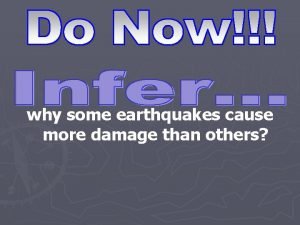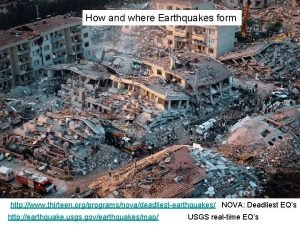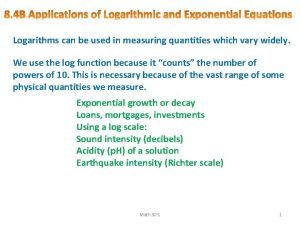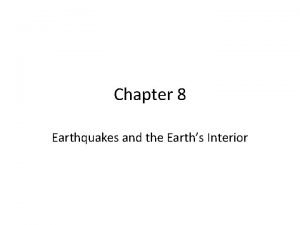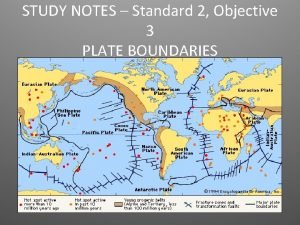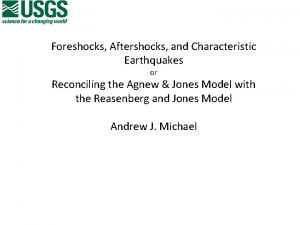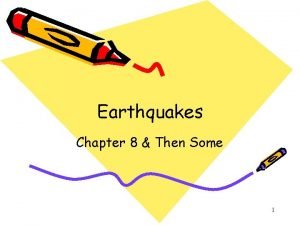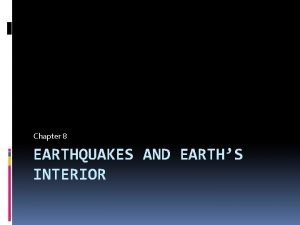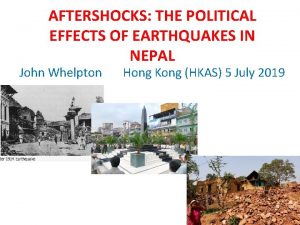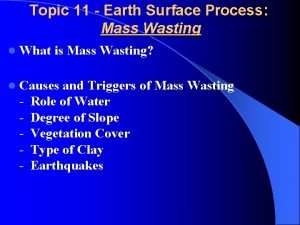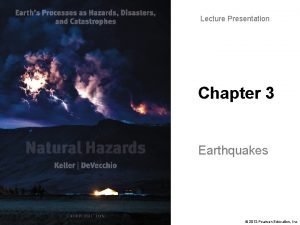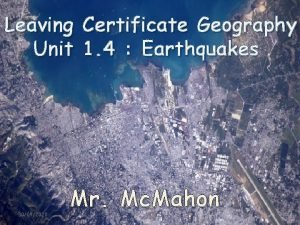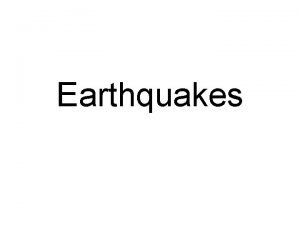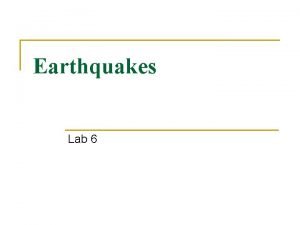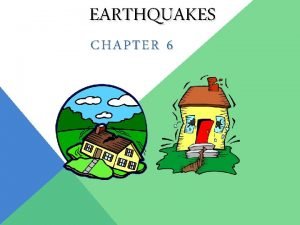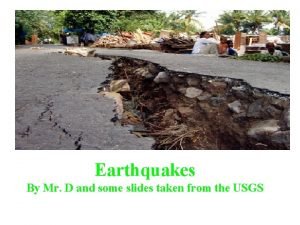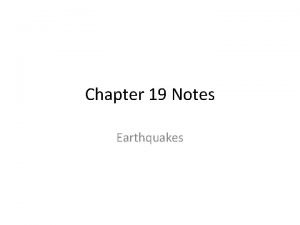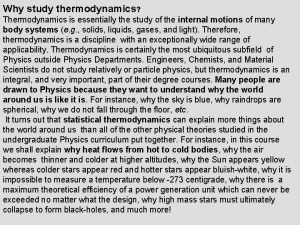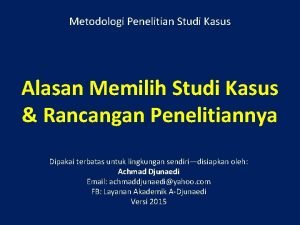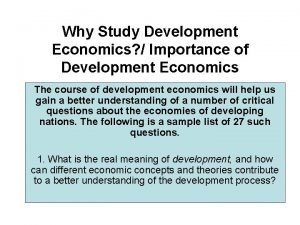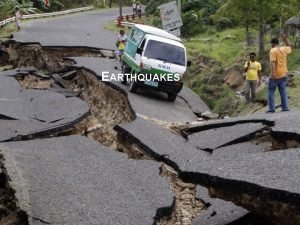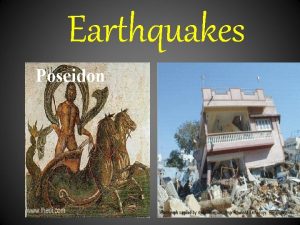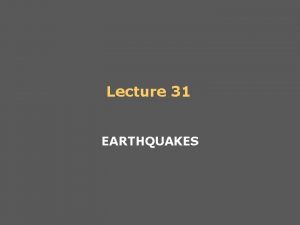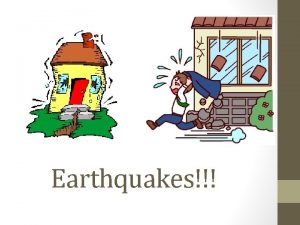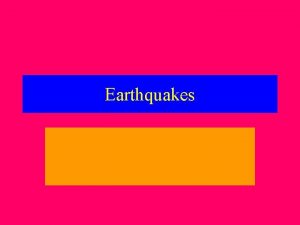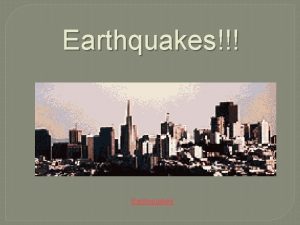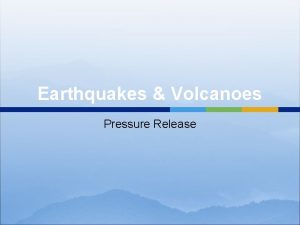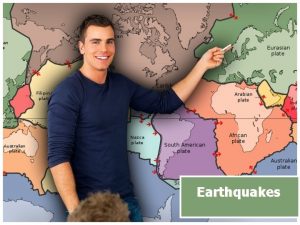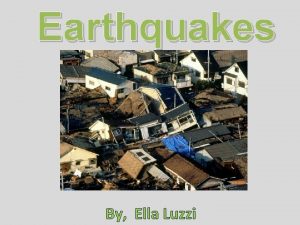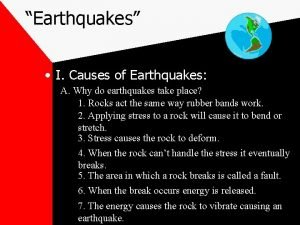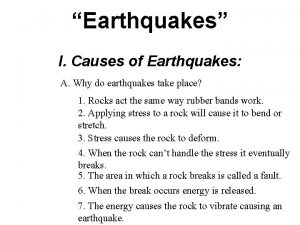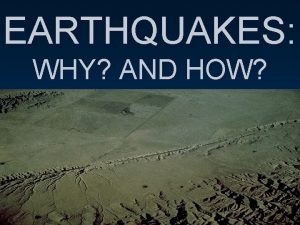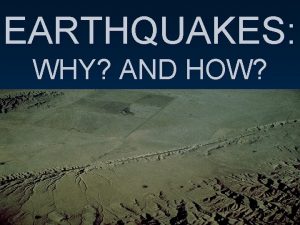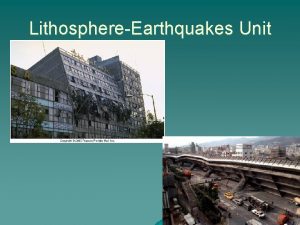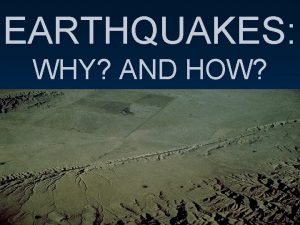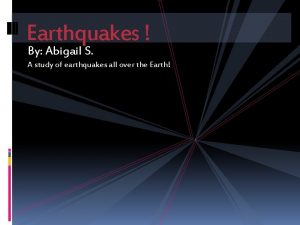Earthquakes Earthquakes Why study earthquakes What is an








































- Slides: 40

Earthquakes

Earthquakes • Why study earthquakes? • What is an earthquake? • Seismographs • Locating earthquakes • Earthquake destruction • Hazards of earthquakes Damage in Golcuk, Turkey after a magnitude 7. 4 earthquake, August 17, 1999

What is an earthquake? • An earthquake is the vibration of Earth produced by the rapid release of energy • Energy radiates in all directions from its source, the focus • Energy moving outward from the focus of an earthquake travels in the form of seismic waves • Seismographs record the event

• Earthquakes and faults • Earthquakes are associated with faults • Movement along a fault produces earthquake and waves • Motion along faults can be explained by plate tectonics

Why study earthquakes? • Understand the hazard to minimize the risk.

Earthquakes • Earthquakes release accumulated strain by the sudden displacement of faults. • Elastic Rebound Theory – energy can be stored in elastically deformed rock, earthquakes release that stored energy and the rock returns to its undeformed state.

Elastic rebound. As rock is deformed it bends, storing elastic energy. Once the rock is strained beyond its breaking point it rupture, releasing the store-up energy in the form of earth waves.

An example of elastic rebound • Slip of nearly 3 m as a result of the 1906 San Francisco earthquake.

Seismology and Seismographs • Seismology – the study of earthquakes • Seismographs are used to observe and record earthquake motion and vibrations.

Location of an Earthquake • Earthquake focus – location where seismic energy is first released. • Epicenter – the point on the surface directly above the focus.

• Types of seismic waves • Surface waves – Complex motion (up-and-down and side-toside) – Causes damage to structures during an earthquake – High amplitude and low velocity – Longest periods (interval between crests) – Termed long, or L waves – Slowest

Surface waves travel along the outer part of Earth

• Types of seismic waves • Body waves – Travel through Earth’s interior – Two types based on mode of travel – Primary (P) waves » Primary, Push-pull motion » Travel through solids, liquids & gases » Travel fastest of the seismic waves – Secondary (S) waves » Secondary, shaking, shear, side-to-side » Moves at right angles to their direction of travel » Travels only through solids

Body waves travel through the interior of Earth


Travel-time graph used to find distance to epicenter The difference in arrival time of th First P wave and Wave in the Example is 5 min

Typical seismic record. Note the time interval (about 5 minutes) between the arrival of the first P waves and the arrival of the first S waves

Locating the earthquake • The distance from each station to the earthquake is plotted. • The intersection of three or more circles shows the location of the epicenter. • Much of the calculation is now automated to give preliminary estimates of magnitude and location.

Measuring the size of earthquakes • Two measurements describe the size of an earthquake • Intensity – a measure of earthquake shaking at a given location based on amount of damage • Magnitude – estimates the amount of energy released by the earthquake


• Magnitude scales • Richter magnitude - concept introduced by Charles Richter in 1935 • Richter scale – Based on amplitude of largest seismic wave recorded – Each unit of Richter magnitude corresponds to 10 X increase in wave amplitude and 32 X increase in energy

The Richter scale is based on the relationship between distance from the epicenter (or the difference in arrival time between P and S waves), and the maximum amplitude The amplitude at a given distance is a function of the energy released by the earthquake


World Seismicity

Earthquakes-related hazards Earthquake-related damage comes from a number of effects: 1) Ground motion 2) Ground failure 3) Tsunamis and flooding 4) Fire

Kobe, 1995 San Francisco, 1906 Ground motion Cause breakage of Power lines, pipelines, Buildings, roads, bridges, and other structures Loma Prieta, 1989 Niigata, 1964

Loma Prieta, 1989 Ground failure Fractures and landslides (hilly areas) Armenia, 1988

Ground failure • Soil liquifaction: Ground shaking may cause a problem in areas where the ground is very wet • As a consequence of liquefaction, soft, young, water-saturated, well sorted, fine grain sands and silts behave as viscous fluids rather than solids. • Liquifaction takes place when seismic waves pass through a saturated granular soil layer, distort its granular structure, and cause some of its pore spaces to collapse.



Ground failure Kobe, 1995 Niigata, 1964 San Francisco, Marina District (Loma Prieta, 1989)

Tsunamis • Tsunamis, or seismic sea waves • Earthquakes under the ocean • Destructive waves called “tidal waves” • Result from “push” of fault block • In shallow coast water wave can be > 30 meters • Very destructive

Formation of a tsunami by displacement of the ocean floor The speed of a wave moving across the ocean correlates with the ocean depth.

Tsunamis Alaska, 1964 Niigata, 1964 Indonesia, 1992

Turkey, 1999 Flooding Alaska, 1964

Fire San Francisco, 1906 Loma Prieta, 1989 Turkey, 1999 Kobe, 1995

Earthquake destruction • Amount of structural damage depends on • Intensity and duration of vibrations • Nature of the material upon which the structure rests (hard rock good, soft bad) • Design of the structure

Structural damage and reinforced structures

Structural damage and materials

https: //www. youtub e. com/watch? v=G_ y. Xi. Q 19 wx. Q
 Why why why why
Why why why why The ______ of a seismograph moves.
The ______ of a seismograph moves. Why do earthquakes occur
Why do earthquakes occur Dont ask
Dont ask In what section of earth do earthquakes happen?
In what section of earth do earthquakes happen? Btn earthquakes
Btn earthquakes Chapter 8 section 1 what are earthquakes
Chapter 8 section 1 what are earthquakes Natural calamities definition
Natural calamities definition Http://earthquake.usgs.gov/earthquakes/map/
Http://earthquake.usgs.gov/earthquakes/map/ Chapter 8 earthquakes and volcanoes
Chapter 8 earthquakes and volcanoes A large crack in the earth formed by a river or earthquakes
A large crack in the earth formed by a river or earthquakes Chapter 8 earthquakes and earth's interior
Chapter 8 earthquakes and earth's interior Chapter 19 earthquakes
Chapter 19 earthquakes Frequent earthquakes in an area may indicate
Frequent earthquakes in an area may indicate Earthquakes
Earthquakes Quiz 1 earthquakes
Quiz 1 earthquakes Chapter 8 earthquakes and earth's interior answer key
Chapter 8 earthquakes and earth's interior answer key Earthquakes
Earthquakes Landslides caused by earthquakes
Landslides caused by earthquakes Plastic deformation earthquakes
Plastic deformation earthquakes Do earthquakes happen
Do earthquakes happen 5 effects of earthquakes
5 effects of earthquakes What is liquefaction in geography
What is liquefaction in geography The point on the ground directly above the focus
The point on the ground directly above the focus Crust definition
Crust definition Causes of earthquake
Causes of earthquake What are the factors of earthquake
What are the factors of earthquake Types of fault in geology
Types of fault in geology Chapter 19 earthquakes
Chapter 19 earthquakes What is case series
What is case series Retrospective cohort study vs prospective cohort study
Retrospective cohort study vs prospective cohort study What is work study in management
What is work study in management Marty lobdel
Marty lobdel Phytogeographic regions of india
Phytogeographic regions of india Difference between time study and motion study
Difference between time study and motion study Distinguish between time study and motion study
Distinguish between time study and motion study Why do we study thermodynamics
Why do we study thermodynamics Why study financial markets?
Why study financial markets? Biotechnology
Biotechnology Alasan menggunakan studi kasus
Alasan menggunakan studi kasus Why study development economics
Why study development economics

